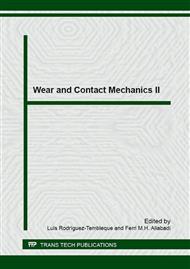[1]
Chen, X., Hisada, T.: Development of a finite element contact analysis algorithm to pass the patch test. Japan Society of Mechanical Engineers International Journal 49(4), 483-491 (Series A 2006).
DOI: 10.1299/jsmea.49.483
Google Scholar
[2]
Fischer, K.A., Wriggers, P.: Mortar based frictional contact formulation for higher order interpolations using the moving friction cone. Comput. Methods Appl. Mech. Engrg. 195, 5020-5036 (2006).
DOI: 10.1016/j.cma.2005.09.025
Google Scholar
[3]
Hallquist, J., Goudreau, G., Benson, D.: Sliding interfaces with contact-impact in large-scale lagrangian computations. Comput. Methods Appl. Mech. Engng. 51, 107-137 (1985).
DOI: 10.1016/0045-7825(85)90030-1
Google Scholar
[4]
Hartmann, S., Ramm, E.: A mortar based contact formulation for non-linear dynamics using dual lagrange multipliers. Finite Elem. Anal. Des. 44, 245-258 (2008).
DOI: 10.1016/j.finel.2007.11.018
Google Scholar
[5]
Kim, J.Y., Youn, S.K.: Isogeometric contact analysis using mortar method. Int. J. Numer. Meth. Engng. 89, 1559-1581 (2012).
DOI: 10.1002/nme.3300
Google Scholar
[6]
Krstulovic-Opara, L., Wriggers, P., Korelc, J.: A C1-continuous formulation for 3D finite deformation frictional contact. Comput. Struct 29, 27-42 (2001).
DOI: 10.1007/s00466-002-0317-z
Google Scholar
[7]
Krstulovic-Opara, L., Wriggers, P., Korelc, J.: A C1-continuous formulation for 3D finite deformation frictional contact. Compt. Mechanics 29, 27-42 (2002).
DOI: 10.1007/s00466-002-0317-z
Google Scholar
[8]
Lorenzis, L.D., Termizer, I., Wriggers, P., Zavarise, G.: A large deformation frictional contact formulation using NURBS-based isogeometric analysis. Int. J. Numer. Meth. Engng. 10, 31-59 (2011).
DOI: 10.1002/nme.3159
Google Scholar
[9]
Lorenzis, L.D., Wriggers, P., Zavarise, G.: A mortar formulation for 3d large deformation contact using NURBS based isogeometric analysis and the augmented lagrangian method. Comput. Mech. 4, 555-566 (2011).
DOI: 10.1007/s00466-011-0623-4
Google Scholar
[10]
Luo, C., Klisinski, M.: Application of piece-wise linear weight functions for 2D 8-node quadrilateral element in contact problems. Int. J. Num. Meth. Engng. 61, 159-188 (2004).
DOI: 10.1002/nme.927
Google Scholar
[11]
Nguyen, D.T.: Modélisation 2D par éléments finis du contact: effet de l'utilisation de méthodes de représentation des surfaces présentant un ordre de continuité élevé et méthodes permettant de passer le patch test (in French). Ph.D. thesis, University of Liège (Belgium) (2014).
DOI: 10.1080/12506559.1999.10511414
Google Scholar
[12]
Nguyen, D.T., Rauchs, G., Ponthot, J.P.: The impact of surface higher order differentiability in two-dimensional contact elements. Journal of Computational and Applied Mathematics 246, 195-205 (2013).
DOI: 10.1016/j.cam.2012.10.024
Google Scholar
[13]
Papadopoulos, P., Taylor, R.L.: A mixed formulation for the finite element solution of contact problems. Comput. Methods Appl. Mech. Engrg. 94, 373-389 (1992).
DOI: 10.1016/0045-7825(92)90061-n
Google Scholar
[14]
Popp, A., Gee, M.W., Wall, W.A.: A finite deformation mortar contact formulation using a primal dual active set strategy. Int. J. Numer. Meth. Engng. 79, 1354-1391 (2009).
DOI: 10.1002/nme.2614
Google Scholar
[15]
Popp, A., Wohlmuth, B., Gee, M., Wall, W.: Dual quadratic mortar finite element methods for 3D finite deformation contact. SIAM J. SCI. COMPUT. 34, 421-446 (2012).
DOI: 10.1137/110848190
Google Scholar
[16]
Puso, M.A., Laursen, T.A.: A mortar segment-to-segment contact method for large deformation solid mechanics. Comput. Methods Appl. Mech. Engrg. 193, 601-629 (2004).
DOI: 10.1016/j.cma.2003.10.010
Google Scholar
[17]
Puso, M.A., Laursen, T.A., Solberg, J.: A segment-to-segment mortar contact method for quadratic elements and large deformations. Comput. Methods Appl. Mech. Engrg. 197, 555- 566 (2008).
DOI: 10.1016/j.cma.2007.08.009
Google Scholar
[18]
Sauer, R.: Enriched contact finite elements for stable peeling computations. Int. J. Numer. Meth. Engng. 87, 593-616 (2011).
DOI: 10.1002/nme.3126
Google Scholar
[19]
Sauer, R.: Local finite element enrichment strategies for 2D contact computations and a corresponding post-processing scheme. Comput. Mech 52, 301-319 (2013).
DOI: 10.1007/s00466-012-0813-8
Google Scholar
[20]
Sheng, D., Wriggers, P., Sloan, S.W.: Improved numerical algorithms for frictional contact in pile penetration analysis. Comput. Geotech. 33, 341-354 (2006).
DOI: 10.1016/j.compgeo.2006.06.001
Google Scholar
[21]
Simo, J., Wriggers, P., Taylor, R.: A perturbed lagrangian formulation for the finite element solution of contact problems. Comput. Methods Appl. Mech. Engrg. 50, 163-180 (1985).
DOI: 10.1016/0045-7825(85)90088-x
Google Scholar
[22]
Stupkiewicz, S.: Extension of the node-to-segment contact element for surface-expansiondependent contact laws. Int. J. Num. Meth. Engng. 50, 739-759 (2001).
DOI: 10.1002/1097-0207(20010130)50:3<739::aid-nme49>3.0.co;2-g
Google Scholar
[23]
Taylor, R., Papadopoulos, P.: On a patch test for contact problems in two dimensions. Computational Methods in Nonlinear Mechanics pp.690-702 (1991).
Google Scholar
[24]
Termizer, I., Wriggers, P., Hughes, T.J.R.: Contact treatment in isogeometric analysis with NURBS. Comput. Methods. Appl. Mech. Engrg. 200, 1100-1112 (2011).
DOI: 10.1016/j.cma.2010.11.020
Google Scholar
[25]
Timoshenko, S., Goodier, J.N.: Theory of Elasticity. Second Edition, Mc Graw-Hill Book Company, Inc, New York (1951).
Google Scholar
[26]
Tur, M., Fuenmayor, F., Wriggers, P.: A mortar-based frictional contact formulation for large deformations using lagrange multipliers. Comput. Methods Appl. Mech. Engrg. 198, 2860-2873 (2009).
DOI: 10.1016/j.cma.2009.04.007
Google Scholar
[27]
Tur, M., Giner, E., Fuenmayor, F., Wriggers, P.: 2D contact smooth formulation based on the mortar method. Comput. Methods Appl. Mech. Engrg. 247-248, 1-14 (2012).
DOI: 10.1016/j.cma.2012.08.002
Google Scholar
[28]
Wriggers, P.: Computational contact mechanics. John Wiley & Sons (2002).
Google Scholar
[29]
Wriggers, P., Krstulovic-Opara, L., Korelc, J.: Smooth C1-interpolation for two-dimensional frictional contact problems. Int. J. Numer. Meth. Engng 57, 2177-2203 (2001).
DOI: 10.1002/nme.227
Google Scholar
[30]
Wriggers, P., Simo, J.: A note on tangent stiffness for fully nonlinear contact problems. Commun. Appl. Numer. Methods 1, 199-203 (1985).
DOI: 10.1002/cnm.1630010503
Google Scholar
[31]
Wriggers, P., Van, T., Stein, E.: Finite element formulation of large deformation impact-contact problems with friction. Comput. Struct 37, 319-333 (1990).
DOI: 10.1016/0045-7949(90)90324-u
Google Scholar
[32]
Yang, B., Laursen, T., Meng, X.: Two dimensional mortar contact methods for large deformation frictional sliding. Int. J. Numer. Methods Eng. 62, 1183-1225 (2005).
DOI: 10.1002/nme.1222
Google Scholar
[33]
Zavarise, G., Boso, D., Schrefler, B.: A contact formulation for electrical and mechanical resistance. In Proceedings of CMIS, III Contact Mechanics International Symposium, Martins JAC, Monteiro Marques MDP (eds). Praja de Consolacao: Portugal pp.211-218 (2001).
DOI: 10.1007/978-94-017-1154-8_22
Google Scholar
[34]
Zavarise, G., Lorenzis, L.: The node-to-segment algorithm for 2D frictionless contact: Classical formulation and special cases. Comput. Methods. Appl. Mech. Engrg. 198, 3428-3451 (2009).
DOI: 10.1016/j.cma.2009.06.022
Google Scholar
[35]
Zavarise, G., Lorenzis, L.D.: A modified node-to-segment algorithm passing the contact patch test. Int. J. Num. Meth. Engng. 79, 379-416 (2009).
DOI: 10.1002/nme.2559
Google Scholar


